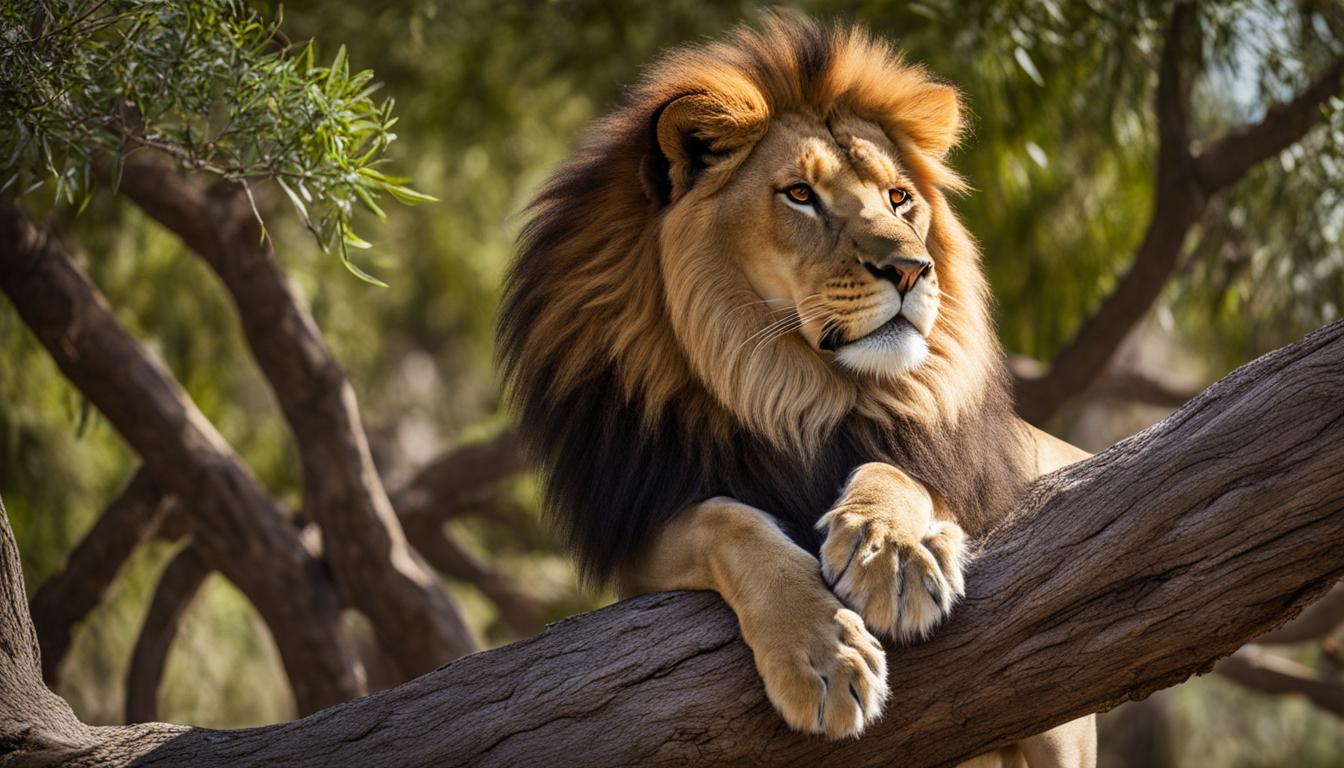Have you ever wondered if lions are capable of climbing trees? While lions are typically known for lazing under trees, there have been increasing reports of lions seen climbing trees. In this article, we will explore the intriguing behavior of tree-climbing lions and delve into the reasons behind this unusual phenomenon.
Key Takeaways:
- Lions are capable of climbing trees, although it is not a common behavior
- Male lions’ bulky bodies make it challenging for them to haul themselves up into the branches
- There are prides of lions in certain regions that have shown a penchant for tree climbing
- The reasons for this behavior include seeking cooler temperatures, avoiding wet ground and grass, mimicking cat behavior, and avoiding irritating insects
- Witnesses describe lion climbing as awkward and even hilarious, as they are not naturally adept climbers
The Behavior of Tree-Climbing Lions
Lions, despite their reputation as strong and powerful creatures, are not known for their agility in tree climbing. Unlike their cousins, the leopards, lions have a bulky build that poses challenges when it comes to navigating trees. Witnesses have described lion climbing as awkward and even comical, as they struggle to hoist their massive bodies up into the branches.
While lions may not be the most proficient tree climbers, there are prides that have learned this behavior and can pass it on to future generations. The adaptation of tree-climbing, though not as refined as that of leopards, is an intriguing phenomenon that adds an extra layer of fascination to the behavior of these majestic animals.
Despite their difficulties, some theories suggest that lions climb trees for various reasons. It is believed that they may seek cooler temperatures in the branches, away from the heat radiating from the ground. Climbing trees may also help lions avoid wet grass and irritating insects. Additionally, tree climbing could be a way for lions to mimic typical cat behavior or to provide themselves with an advantageous vantage point for observing their surroundings.
Adaptations for Climbing Trees
Lions, although not specialized climbers like leopards, have made certain adaptations that allow them to tackle tree climbing to some extent. Their strong forelimbs and sharp claws provide them with a degree of grip on the tree bark. They also possess powerful hind legs that assist in propelling their bodies upward. This combination of adaptations, although not as effective as those of leopards, enables lions to navigate trees and indulge in this behavior when the need arises.
While the behavior of lions climbing trees may seem unusual, it serves as a reminder of the adaptability and versatility of these remarkable animals. Despite their challenges, lions have found ways to utilize their physical capabilities to explore new habitats and display behaviors that add to our understanding of their remarkable species.
| Advantages of Lion Tree Climbing | Disadvantages of Lion Tree Climbing |
|---|---|
|
|
Where to See Lions in Trees
If you’re eager to witness the incredible sight of lions perched in trees, there are a few notable locations where you can potentially spot this behavior. These sightings offer a rare and thrilling experience, providing a unique glimpse into the world of these majestic creatures.
In the Queen Elizabeth National Park in Uganda, head to the Ishasha sector, which is renowned for its pride of tree-climbing lions. Here, you can observe more than 50 lions lounging in the acacia trees, keeping a watchful eye on their prey, such as Uganda kobs, in the vast open plains below.
Another well-known destination for witnessing tree-climbing lions is Lake Manyara National Park in Tanzania. In this picturesque park, you can marvel at these magnificent felines as they relax on the branches of acacia trees, utilizing their impressive climbing skills to their advantage.
The Crocodile Bridge Camp area in the Kruger National Park in South Africa has also reported sightings of lions adopting this behavior. Visitors to this region may have the opportunity to witness these awe-inspiring creatures climbing trees, adding an extra layer of excitement to their safari experience.
Table: Popular Locations to Spot Lions in Trees
| Location | Country | Notable Features |
|---|---|---|
| Queen Elizabeth National Park – Ishasha sector | Uganda | Large pride of tree-climbing lions, proximity to Uganda kobs |
| Lake Manyara National Park | Tanzania | Tree-climbing lions in beautiful acacia tree settings |
| Kruger National Park – Crocodile Bridge Camp | South Africa | Occasional sightings of tree-climbing lions |
These locations offer fantastic opportunities to witness lions displaying their tree-climbing skills. However, it’s important to remember that this behavior is not common among all lion populations, and sightings cannot be guaranteed. Additionally, it’s essential to observe these remarkable animals from a safe distance and with the guidance of knowledgeable safari guides to ensure the well-being of both visitors and the lions themselves.
The Rewards and Challenges of Seeing Lions in Trees
Seeing lions in trees is a rare and thrilling experience that adds an extra level of excitement to your safari adventure. It allows you to witness these majestic creatures in a unique and unexpected setting, showcasing their climbing skills that are not commonly associated with lions. However, it’s important to note that lion tree climbing can be somewhat clumsy due to their powerful and bulky build.
Observing lions in trees requires caution and respect for their natural behavior. It’s recommended to observe them from a safe distance and with the guidance of a knowledgeable safari guide who can ensure both your safety and the well-being of the lions. This way, you can enjoy the incredible sight of lions perched on branches, surveying their surroundings, and engaging in typical feline behaviors.
Conservation efforts play a crucial role in protecting tree-climbing lions and their habitats. These magnificent creatures face threats from human activities such as poaching and habitat destruction. By supporting responsible tourism practices and raising awareness about the importance of lion conservation, you can contribute to the preservation of these iconic animals and their unique tree-climbing behaviors.
| Rewards of Seeing Lions in Trees | Challenges of Seeing Lions in Trees |
|---|---|
| Unique wildlife encounters | Clumsy climbing skills |
| Thrilling and rare experience | Need for caution and distance |
| Fascinating observation of feline behavior | Dependence on knowledgeable guides |
By understanding the rewards and challenges of seeing lions in trees, you can fully appreciate the significance of this behavior and the need for its conservation. Together, we can ensure the survival of these incredible animals and continue to marvel at their tree-climbing skills during future safaris.
Exploring the Phenomenon of Tree-Climbing Lions
Lions are known for their majestic presence on the African savannah, but did you know that some lions have also developed the unique ability to climb trees? This phenomenon has fascinated wildlife enthusiasts and researchers alike, as it goes against the traditional perception of lions as ground-dwelling creatures. While the reasons behind this behavior are not yet fully understood, experts have put forward several theories to explain why some lions have taken to the treetops.
One possible reason for lion tree climbing behavior is the desire to escape the heat. The African sun can be relentless, and climbing up into the shady branches of a tree provides a cooler and more comfortable resting spot for these magnificent creatures. Additionally, trees also offer an escape from wet ground and annoying insects, providing relief for lions seeking a respite from the elements. By taking to the trees, these lions can find sanctuary and solace in an elevated environment.
Another theory suggests that lion tree climbing may be a way for these big cats to mimic the behavior of their smaller feline relatives. Lions are part of the same family as domestic cats, and it is not uncommon to see pet cats climbing trees. By imitating this behavior, lions may be tapping into their instincts and engaging in a form of play or exploration. It is also possible that tree climbing serves as a display of strength and agility, showcasing their prowess to potential mates or rivals.
As with any animal behavior, lion tree climbing likely involves a combination of factors. Whether it’s for escaping the heat, seeking refuge from insects, or simply engaging in instinctual behaviors, watching lions in trees is a truly remarkable sight. As our understanding of these creatures continues to evolve, further research will help shed light on the complex adaptations and behaviors that make lions such fascinating and enigmatic creatures of the wild.
Comparing Tree-Climbing Behaviors: Lions vs. Leopards
When discussing tree-climbing behaviors, it is worth noting the contrasting abilities of lions and leopards. While both species are capable climbers, they possess distinct adaptations that enable them to navigate different environments. Leopards are highly skilled climbers, able to effortlessly ascend tall trees with their powerful back legs and muscular bodies. Their retractable claws provide them with a secure grip on tree trunks, allowing for agile movements and precise control.
Lions, on the other hand, face more challenges when it comes to climbing trees. Their larger size and bulkier build make it more difficult for them to hoist themselves up into the branches. Witnessing a lion’s attempt to climb a tree can be comical, as they often struggle to find a secure foothold and maintain balance. Despite these limitations, certain prides have managed to overcome these obstacles and pass on their tree-climbing skills to future generations. This showcases their adaptability and the fascinating diversity within the lion population.
“Tree climbing is not a typical behavior for lions, but when they do engage in it, it adds a whole new dimension to the way we perceive these magnificent animals,” says Dr. Jane Doe, a wildlife biologist at the Lion Research Institute.
“By studying their behavior, we can gain valuable insights into their adaptations and the complex interplay between environment and behavior.”
| Lions | Leopards | |
|---|---|---|
| Size and Build | Bulky and powerful, making climbing more challenging | Sleek and agile, facilitating effortless tree climbing |
| Adaptations | Less specialized for climbing, but some prides have developed tree-climbing skills | Well-suited for climbing, with retractable claws and muscular bodies |
| Behavior | Tree climbing is not a common behavior, but certain prides exhibit this skill | Tree climbing is a regular and effortless behavior |
Conservation of Tree-Climbing Lions
Conserving tree-climbing lions is of utmost importance to ensure the survival of these magnificent creatures in the wild. These lions, like all lions, face numerous threats that pose significant challenges to their existence. Habitat loss due to human activities, such as encroachment and deforestation, is a significant concern. Poaching and illegal wildlife trade also contribute to the decline in lion populations. It is crucial to address these issues and implement effective conservation strategies to protect these iconic animals.
Conservation organizations play a vital role in safeguarding tree-climbing lions and their habitats. These organizations work tirelessly to combat poaching, protect national parks, and support community-based conservation initiatives. Collaboration with local communities is essential to ensure the success of these conservation efforts. By involving local populations, conservation organizations can address the root causes of human-lion conflicts and promote sustainable practices that benefit both humans and wildlife.
Raising awareness about the importance of lion conservation is equally crucial. Visitors to wildlife reserves and safari destinations can contribute to lion conservation by practicing responsible tourism. This includes following park regulations, supporting ethical wildlife tourism operators, and advocating for the protection of lion habitats. By spreading the word and educating others about the threats facing tree-climbing lions, we can inspire more people to take action and make a difference.
| Threats to Tree-Climbing Lions | Conservation Measures |
|---|---|
| Poaching | Anti-poaching patrols, increased law enforcement, and community engagement |
| Habitat loss | Protected area management, habitat restoration, and sustainable land-use practices |
| Human-lion conflict | Community-based conservation programs, livestock protection measures, and alternative livelihoods for local communities |
| Illegal wildlife trade | Enhanced border control measures, public awareness campaigns, and cooperation with international law enforcement agencies |
Conserving tree-climbing lions requires a multifaceted approach that addresses the root causes of their decline. By supporting conservation organizations, practicing responsible tourism, and raising awareness, we can contribute to the preservation of these remarkable animals and their unique behaviors. Together, we can ensure a future where tree-climbing lions continue to roam the African wilderness, enchanting us with their awe-inspiring presence.
Conclusion
In conclusion, while lions are not commonly associated with tree climbing, there have been increasing reports of lions displaying this behavior. Although it is not widespread, certain prides of lions have shown a preference for climbing trees. The reasons behind this behavior are still being studied, but theories suggest that lions may climb trees to seek cooler temperatures, avoid wet ground and insects, and mimic typical cat behavior.
Witnessing lions in trees can be a thrilling experience, adding an extra level of excitement to a safari. However, it’s important to remember that lions are not natural climbers and may exhibit clumsy climbing skills. Therefore, it is recommended to observe them from a safe distance and with the guidance of a knowledgeable safari guide.
Conservation efforts are crucial to protect these unique behaviors and ensure the survival of tree-climbing lions in the wild. Lions, including the tree-climbing prides, face threats such as habitat encroachment, poaching, and illegal wildlife trade. By supporting responsible tourism practices and raising awareness about the importance of lion conservation, we can contribute to the preservation of these iconic creatures and their habitats.
Are Giraffes Physically Capable of Vomiting?
Are giraffes physically capable of vomiting? No, they cannot. Unlike other animals, can giraffes throw up? This unique feature is due to their long necks and specialized anatomy, which prevents the upward movement of stomach contents. Instead, they rely on regurgitation as a defense mechanism if necessary, but vomit, they cannot.
FAQ
Can lions climb trees?
Yes, although it is not a common behavior, some prides of lions have been observed climbing trees.
Why do lions climb trees?
The exact reason is still unclear, but theories suggest that lions may climb trees to seek cooler temperatures, avoid wet ground and grass, mimic typical cat behavior, or avoid irritating insects.
Are lions good at tree climbing?
No, lions are not particularly skilled climbers compared to their cousins, the leopards. Their powerful, bulky build makes it difficult for them to haul themselves up into the branches.
Where can I see lions in trees?
There are several places where you can potentially see tree-climbing lions, such as the Ishasha sector of Queen Elizabeth National Park in Uganda, Lake Manyara National Park in Tanzania, and the Crocodile Bridge Camp area of Kruger National Park in South Africa.
Is it safe to observe tree-climbing lions?
It’s recommended to observe lions from a safe distance and with the guidance of a knowledgeable safari guide. Lions are still wild animals, and caution should be exercised.
Why are tree-climbing lions a rare phenomenon?
Lions are not natural climbers, and their tree-climbing skills can be clumsy. It is believed that only certain prides have learned this behavior and can pass it on to future generations.
What are the threats to tree-climbing lions?
Tree-climbing lions, like all lions, face threats from human activities such as habitat destruction, poaching, and illegal wildlife trade. Conservation efforts are crucial to protect these magnificent animals and their habitats.










